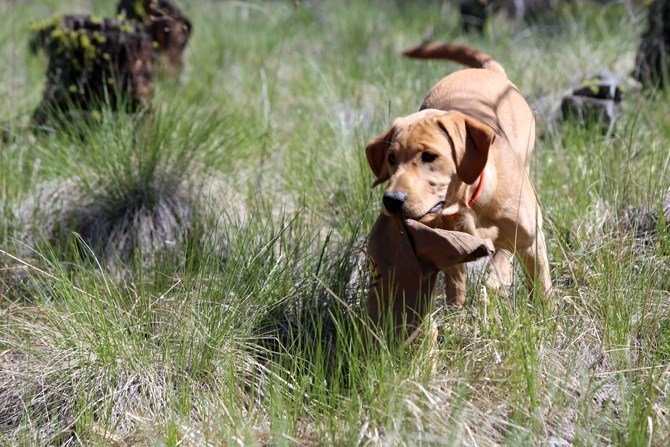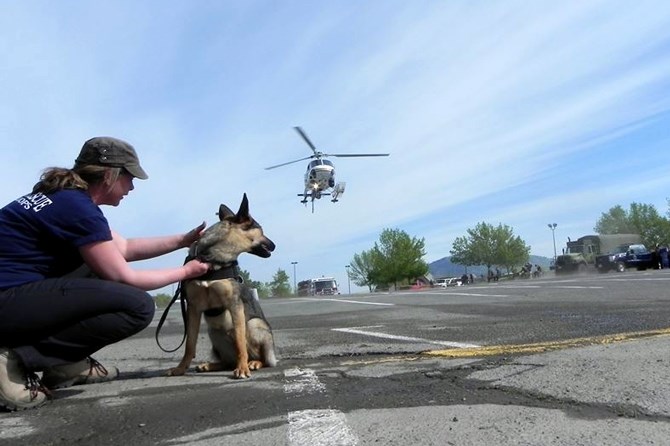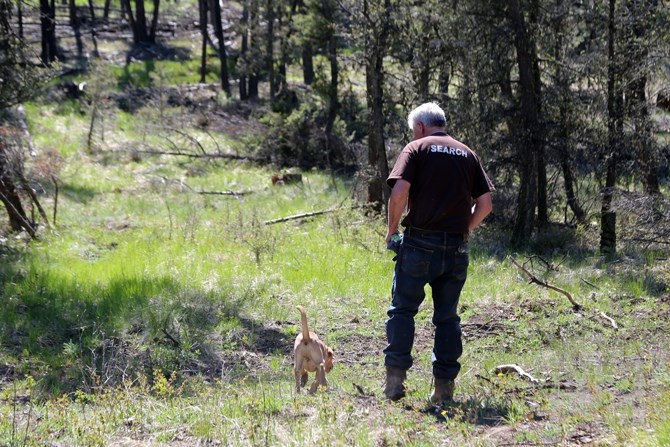
Ruby will get her puppy assessment this fall in the hopes of being accepted as a search and rescue dog in training. She's already showing good drive at a couple months old.
(JENNIFER STAHN / iNFOnews.ca)
June 05, 2015 - 11:30 AM
A LOOK AT THE ONLY VALIDATED SAR DOGS IN SOUTHERN INTERIOR
KAMLOOPS - If you’re lost, they can help find you. If you’re hurt, they can help save you. They are some of the most important, yet underrated members of search and rescue teams and there are less than 20 of them in the entire province.
In the Southern Interior, there are just two validated search and rescue dogs. Meet Juno and Vida.
In just the past couple of weeks Juno, a seven-year-old labrador retriever, has assisted in a search following the Cache Creek flash floods, in looking for a missing mushroom picker and in a cold case search near Lytton (which Vida, a two-year-old weimaraner, also helped on.)

Vida and Juno are the only two validated search and rescue dogs currently working in the Southern Interior.
Image Credit: Mike Ritcey
Juno and Vida are both part of the Kamloops Search and Rescue team but the hope is that two more dogs will soon join their ranks.
Mike Ritcey works with Juno, a SAR dog for about six years, and he is now training a young labrador pup, Ruby, in the fine art of search and rescue. Michelle Liebe is also in the midst of training a young German shepherd, Gertie, that is destined to be a search and rescue dog. Vida was only just validated.
Ritcey does at least one search a day with Juno while Ruby gets a lot more training as she gets used to different terrains and smells. Ruby is walking on windfalls, over rock piles and on slippery floors. Ritcey also has neighbour kids hide in big barrels so Ruby gets used to focusing on smell instead of sight.

Juno is helping teach Ruby the ropes of being a search and rescue dog.
(JENNIFER STAHN / iNFOnews.ca)
“It’s hard to say what you call training, but I try to do at least a search a day with three or four articles,” Ritcey says of Juno. “I spend hours and hours (working with Ruby) — at least a couple hours a day. I’ve got all kinds of things I do with her.”
Ruby will get her puppy assessment in September, at which point she will be judged to see if she has the drive, smarts and will to search. Once she passes the assessment it’s on to hardcore training. Ritcey allows Ruby to be a pup and run around right now, but once full search and rescue training starts, the rule is ‘if the vest is on, you’re working.’
It usually takes two to two-and-a-half years to get validated, if you get validated at all. Many dogs fail at the puppy evaluation level and of those who make it past the initial assessment only a handful go on to be validated. Ritcey notes the time commitment can often dissuade people from the necessary training and as a result few dogs ever get validated.

As young Ruby gets used to what is expected of her Mike Ritcey gives her lots of praise and play time when she finds something.
(JENNIFER STAHN / iNFOnews.ca)
Ritcey is hopeful Ruby will catch on quickly. While she has yet to understand the ‘scent cone’ she is responding well to training and is more independent than Juno was early on.
“(Juno) finds without direction, she’s not all over the place and picks up the scent easily,” he notes of their current skill levels. “It’s different with Ruby. I just want her to work, her nose is working but she hasn’t figured out the scent cone yet. There will be a big learning curve, I have to remember that. It’s really important to not get frustrated.”
The scent cone is how dogs can track people. Ground disturbances and the smell people leave behind from dead skin cells (among other things), along with wind direction, all play a part in allowing dogs to track scents.
To Ritcey, dogs are a very important tool for search and rescuers, which is a big part of why he is so willing to put in the time to train yet another dog for this important task. He has seen dogs find things people missed and has seen non-believers converted once they see what dogs bring to a search.
“They can cover an area way faster than humans. If a person is under a log or we can’t see them, the dogs can still smell them,” he says. “They’re just another tool in the toolbox. We work as a team.”

Gertie gets another step into her training with Michelle Liebe by getting used to helicopters.
Image Credit: Mike Ritcey
Search and rescue work is hard on both human and canine. The long hours, the often less-than-ideal conditions or terrain and the sometimes less-than-ideal outcomes can make the volunteer job both mentally and physically draining. When you’re also watching out for your canine companion, which can more easily pick up ticks and injure their paws, the work can be even harder.
But Ritcey, who’s passion for search and rescue and his dogs is more than obvious to anyone who meets him, wouldn’t have it any other way. He’s seen the difference both he and his dogs can make, and that’s what drives him to keep at it and makes the long hours of training yet another dog worth it.

Mike Ritcey is training his second search and rescue dog, Ruby, and hopes she will be as good as his other dog, Juno, is at helping find missing people.
(JENNIFER STAHN / iNFOnews.ca)
To contact a reporter for this story, email Jennifer Stahn at jstahn@infonews.ca or call 250-819-3723. To contact an editor, email mjones@infonews.ca or call 250-718-2724.
News from © iNFOnews, 2015